Bench FAQ
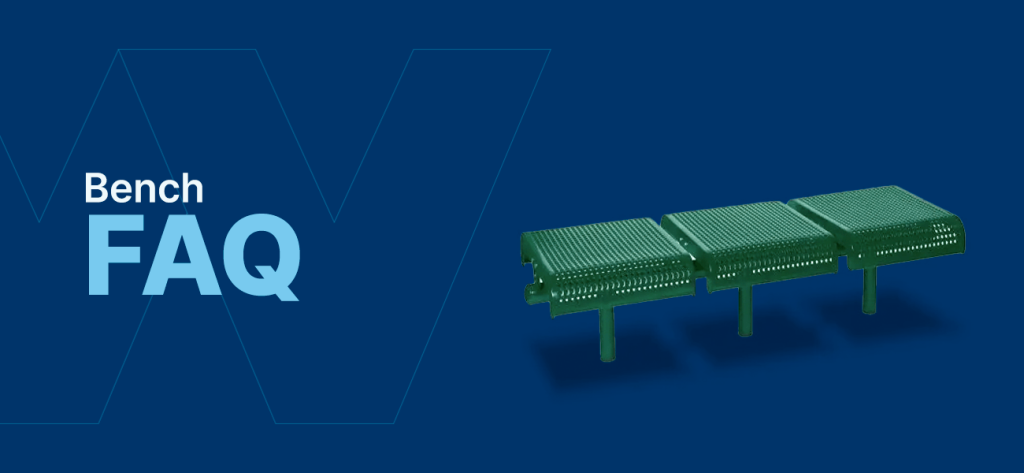
Uncategorized | Dec 22, 2022
Purchasing outdoor benches is a comprehensive process with several considerations. Wabash Valley Site Furnishings is here to answer all your questions, so you can feel more ready to invest in new benches.
Table of Contents
- What are Common Dimensions for Outdoor Benches?
- What are the Best Ways to Secure Benches to the Ground?
- What are Benches Made of?
- What is the Best Material for Outdoor Benches?
- How Should You Cover an Outdoor Bench?
- How Should You Clean a Bench?
- How Much Do Benches Cost?
- What is a Memorial Bench?
What Are Common Dimensions for Outdoor Benches?
Whether you are planning a general layout for an outdoor space or want to fill existing spaces with more seating options, knowing bench dimensions can ensure your investments can fit where you want them. Further, many manufacturers design benches for optimized comfort, so choosing the correct measurements can provide visitors with a better sitting experience and encourage them to return.
What Is the Standard Bench Height?
What is the height of a bench seat? Outdoor benches are typically 18 to 20 inches tall. However, height can depend on several factors.
- Design: While these dimensions are the industry standard, manufacturers might take creative liberties with designs to make them more unique. Some models incorporate sloped seats to make them more comfortable. With the slope, the back of the seat sits one inch lower than the front.
- Features: Various elements in the specific design can change the bench’s height. This standard is for backless outdoor benches. Adding a backrest will increase its height. Further, a gap between the seat and bench might cause more discrepancies among various models.
- Audience: The standard outdoor bench design is ideal for adults. If you are planning a playground or picnic area, you might cater your design choices to children. Benches designed for children will have shorter heights.
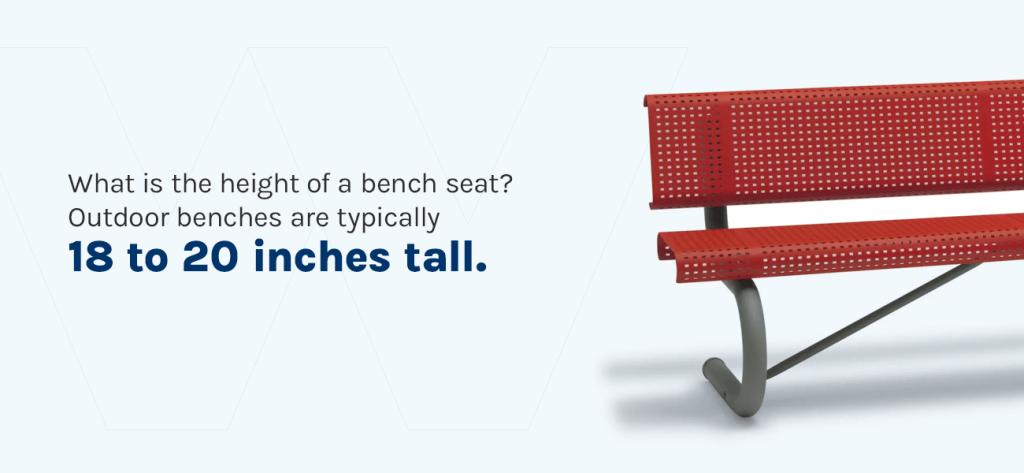
Knowing these dimensions can strengthen your planning and selection processes for your outdoor spaces.
How Long Is a Standard Bench?
Outdoor benches typically range between 42 and 60 inches long. This space can accommodate two adults, though longer benches can fit three. If you want to encourage social interaction or protect personal space in your outdoor areas, choosing a longer bench can support your visitors’ needs.
How Deep Should a Bench Seat Be?
How wide should a bench seat be? Most manufacturers and dealers refer to seat depth and width synonymously when measuring outdoor benches. The standard depth for outdoor benches is around 15 to 20 inches wide. Like seat height, your dimensions might change based on your audience. Children’s benches will likely have narrower seats to accommodate smaller bodies.
How Much Does a Bench Weigh?
Your bench’s weight will depend on the material you choose. Lighter benches are ideal for increased portability, like in picnic or dining areas, so visitors can select seating arrangements and group capacities. Heavier benches are better for more permanent fixtures. This option is excellent when you want to deter theft or prevent damages caused by strong winds, heavy precipitation and flooding.
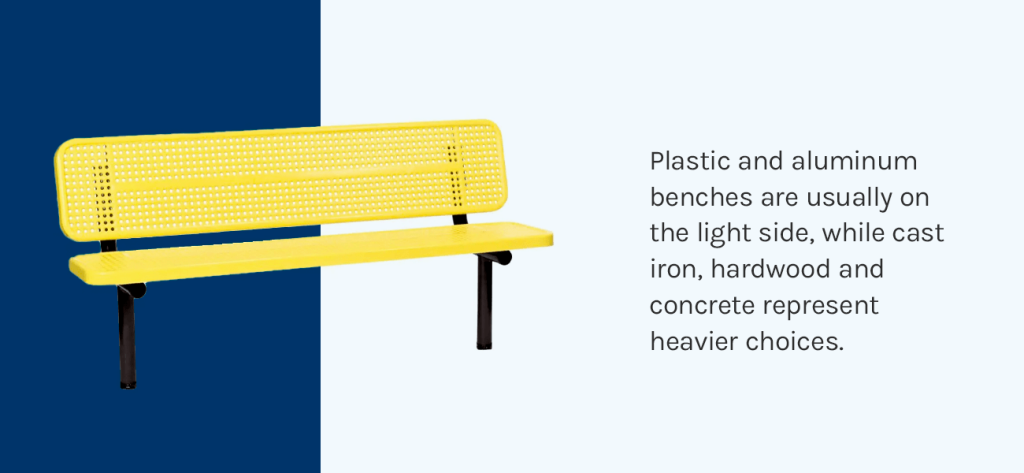
Plastic and aluminum benches are usually on the light side, while cast iron, hardwood and concrete represent heavier choices.
What Are the Best Ways to Secure Benches to the Ground?
While choosing heavier bench materials is one reliable way to keep your benches in place, you can also use other methods to secure them to the ground. Determining how to secure a bench to the ground can streamline your planning efforts, so you can choose the bench aesthetic and material you want while increasing permanency and protection. When securing your benches, you have several options depending on your ground material.
- Concrete: Securing your outdoor benches to concrete surfaces is one of the easier ways. You need to drill holes in the ground and hammer in your anchor type. Once your anchors are in place, you can attach them to your bench. Because of the support and protection this securing type offers, you can apply it to several other ground materials.
- Grass or packed dirt: Many parks and picnic spaces use grass and earth to bring nature into their outdoor spaces. You can maintain a greener feel when you want to protect your benches by implementing the concrete securing method. For this method, you’ll need to remove a portion of grass where the legs will go and fill the hole with concrete. Then, you can follow the same steps for securing your bench to concrete.
- Asphalt: Asphalt is common for basketball courts and sidewalks. You can secure outdoor furniture to asphalt with rebar spikes or with concrete. The concrete option is easy and common. Because concrete is so customizable, you can paint it for a more cohesive securing solution.
- Wooden planks: Restaurants and other social areas might designate seating areas with decks, inviting people to enjoy nature while protecting them from dirt and puddles. To secure your benches to your deck or wooden platform, attach your securing elements between the beams. The gaps allow your safety solution to reach the ground and benches without splitting wooden planks.

Depending on your floor type, your concrete blocks might sink. Putting stone underneath the concrete can provide better support for the concrete and prevent it from moving. You can further protect your benches with the securing method you choose. Anti-theft options incorporate a design without removable components, like nuts or bolts, to prevent people from unscrewing your benches.
What Are Benches Made Of?
What are park benches made of? When selecting an outdoor bench, you find several available material options. Each choice offers different benefits and aesthetics, allowing you to implement the best option for your outdoor spaces.
1. Wood
Wood is a classic outdoor bench option that visitors are familiar with. Wood benches will give your area a rustic and natural look, making it great for parks, playgrounds and other spaces that want to integrate more greenery. It comes in several finishes and colors, from white to almost black. You can also paint and stain your wood benches for increased customization. This material is aesthetically versatile, so you can create the exact look and vibe you want.
Because wood can bend slightly under someone’s weight, it is more comfortable compared to some other options. However, unprotected wood can cause splinters. Sanding your benches and regularly applying a sealant can reduce the risk of splinters and keep pests from making them their home. Sealants can provide increased weather protection, preventing the wood from rotting for increased life spans and more durability.
Wood is relatively easy to maintain, but it requires regular effort. Creating an inspection and care schedule can help your teams stay on top of your bench care for optimized longevity and durability if you choose wood options.
2. Metal
Metal is another common material for outdoor furniture, including benches. As a durable material, it’s less prone to bending and breaking. Like wood, you have multiple customization choices, from pattern to design. Many manufacturers offer perforated benches to prevent precipitation from pooling on the surface. Benches come in various colors, so you can match your furniture to your aesthetic and branding standards. Metal outdoor benches even come in several types of metal, including steel, aluminum and cast iron.
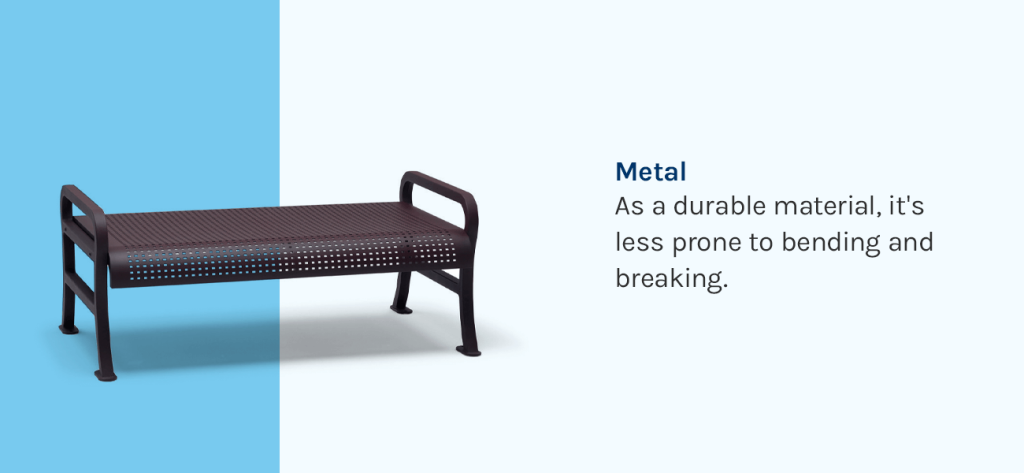
As with wood, you can protect your metal benches with sealants and coatings. Metal protection options have many properties, from preventing corrosion to resisting UV damage and fading. With the appropriate sealant solution, you can decrease necessary maintenance. Instead of regular care, you can inspect and clean the benches periodically.
One downside of installing metal benches is that some visitors find them less comfortable than other materials. Unlike wood, they have little give when people sit on them. Further, their temperature might change with the weather, getting colder in the winter and hotter in the sun. While placement and proper sealants can reduce the weather’s impact on metal benches, this is an aspect to consider when investing in this bench type.
3. Plastic
Plastic is versatile. You can find it in many designs and colors, allowing it to fit seamlessly into your space’s design. Their soft and lightweight material makes them ideal for kids’ areas. When you want more portable seating solutions, this option allows guests to move benches into the arrangement they need and quickly put them back into the original configuration.
Many people like plastic because it is so comfortable. Unlike wood and metal, the material won’t get splinters or rust, making it safe for visitors. Plastic bends under weight, so it can conform to your shape. Plastic might be your option when you want to encourage people to stay for long periods.
How you maintain your plastic bench will depend on the type of plastic and protective measures you implement.
4. Concrete
Concrete is excellent for industrial or modern settings where you want to offer a sleek, clean look with solid features. This option is less common because it is not as comfortable as others, but it is incredibly durable and requires very little maintenance. Because this method is heavier, you can better protect your furniture from theft or weather damage with its weight alone.
5. Recycled Plastic Lumber
If you want a bench material that supports the environment and promotes increased design choices, consider recycled plastic lumber. This option combines the comfort of plastic with design versatility and natural wood elements. The recycled plastic is lighter than hardwood but will still look like the stain and wood type you love. Further, you won’t need to worry about splinters or wood rot with a plastic solution.
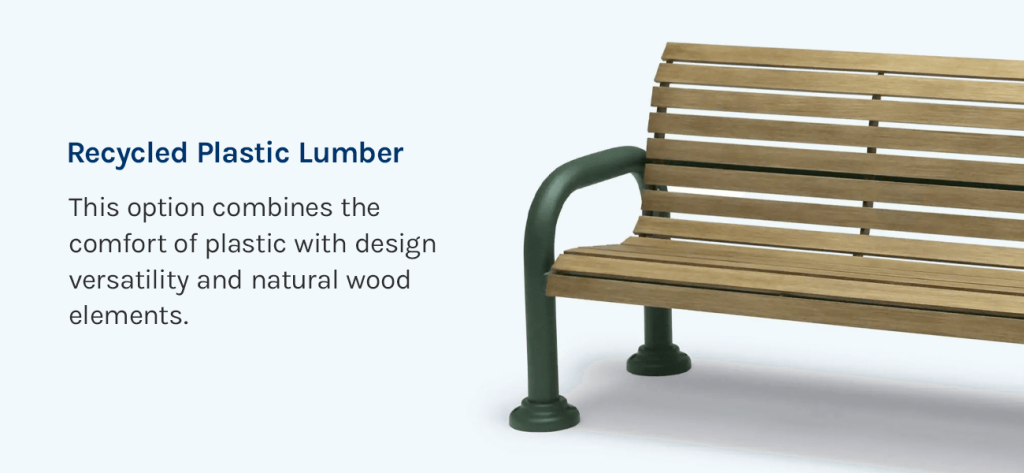
Like regular plastic, recycled plastic lumber requires little maintenance. It can be susceptible to fading in the sun, but the proper coatings and placement can reduce the impact UV rays have on its appearance.
What Is the Best Material for an Outdoor Bench?
While each material offers unique strengths, you can determine which one will best serve your outdoor spaces by considering the following factors.
- Local weather patterns: Your region’s climate can help you choose outdoor furniture solutions. Wood can do poorly in places with lots of rain because it can increase the risk of rotting. Concrete is excellent for areas that frequently flood or get heavy snowfall because it is durable and can withstand various weather elements. Analyzing your weather patterns and how they might affect your bench material can increase longevity and match you with the correct option.
- Intended function: Your bench’s material should support its purpose. If you want an option that promotes socialization, you’ll need something more lightweight so visitors can move benches at will. However, if you want to preserve your established bench placement, a heavier material will prevent people from moving them. Further, some options serve different audiences better than others. Plastic suits kids because it is soft and comfortable.
- Comfort: You want your benches to support your visitors’ preferences. Choosing a bench they’ll want to use can help you maximize your furniture investment. Further, when your guests like your seating options, it can encourage them to stay longer and return, increasing traffic and revenue for your outdoor spaces.
- Maintenance requirements: Because each material has different maintenance and care requirements, you must choose materials that support your available resources. While wood is comfortable and durable, it needs regular care to stay in good shape. If you lack the personnel or time to clean and inspect your wood benches, you might benefit from a more hands-off material, like recycled plastic lumber.
- Aesthetic: When so many material options come in many designs and colors, you can explore your preferred material for a choice that matches your desired aesthetic. You might have a color scheme you already plan to use to attract the right audience, so your bench design selections can support that goal. The color and design you choose can also define your benches’ prominence. Neutral colors that match the surroundings will blend in more, while brighter or contrasting ones will stick out and highlight places where guests can rest.
Choosing an outdoor bench material and design requires lots of research and consideration. Wabash Valley Site Furnishings offers comprehensive online resources for organizations in the planning and designing stage, so you can better discover what your outdoor space needs.
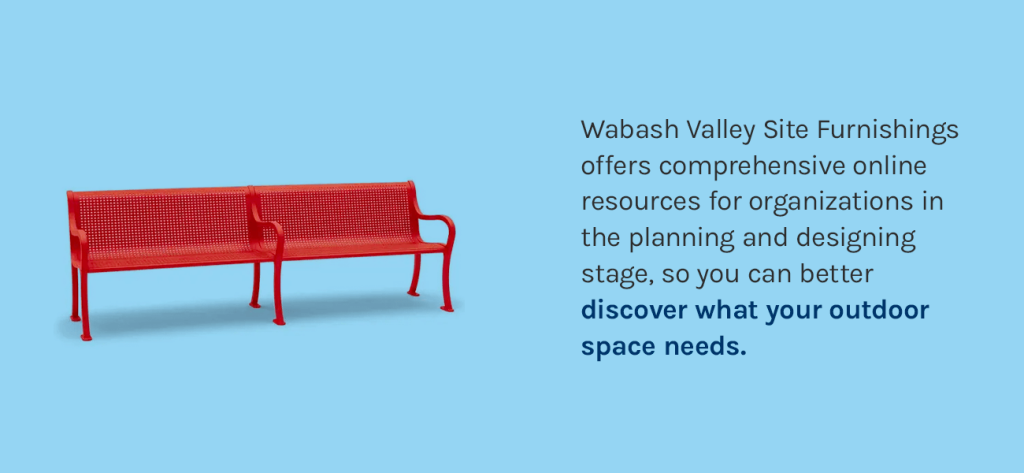
How Should You Cover an Outdoor Bench?
Extreme weather like harsh winters and rainy seasons can harm your outdoor benches and decrease their quality or life span. Long-term exposure to the cold can warp wood and plastic, while moist environments can increase the risk of rotting and rusting. When you want to protect your outdoor benches, you can cover them during the winter or rainy seasons to keep the elements off them.
Knowing how to cover a bench and the various factors that go into it are essential if you are looking into bench covers. Most people cover their benches with a tarp or similar material, and protecting benches this way is usually straightforward. When covering your benches, remember to consider the following factors.
- Tarp size: Your cover’s size needs to correlate to your bench’s dimensions. It should cover your bench completely without leaving gaps at the bottom for weather and debris to get in. A too-small tarp will expose the bench’s legs, while one that’s too big can make it hard to secure the edges. When learning how to cover a bench, knowing what tarp size you’ll need is essential in thoroughly protecting it.
- Fasteners: Your tarp needs something to keep it down. Otherwise, people or rough weather can easily upend it. A fastening solution will allow your tarp to serve your bench in harsh conditions. Tarps with metal rungs around fastening holes will prevent the material from ripping in high winds or storms. You should check the fastener condition for rust and corrosion when getting out your tarps for the season.
- Leaf litter and debris: Properly placing a tarp involves preparing your benches. To preserve your benches’ quality throughout the season, you can prevent rust and rot from growing by thoroughly cleaning your bench, the tarp and the surrounding area. Remove leaf litter and other natural debris from around your bench and clean it one last time before installing the tarp. You should also clean the tarp’s underside to ensure it is ready for the season.
- Material condition: Besides cleaning your tarp, you should inspect its surface the season before. Harsh weather can cause tarps to rip. Animals can make holes in fabric materials. Discovering these damages early can give you enough time to find a proper replacement cover and best protect your benches.
- Use and duration: Covering benches means your visitors can no longer use them. Often, organizations cover benches because people spend less time outdoors in poor weather. However, you might offer seating solutions they can continue to use, like those under structures or shade coverings. When planning your protection method, you should also determine how long you want to cover the benches. While weather can be unpredictable and harsh in any season, uncovering them at the right time can optimize use for visitors.
If you have portable bench options, you can also consider moving them to a shed or storage unit for the season.
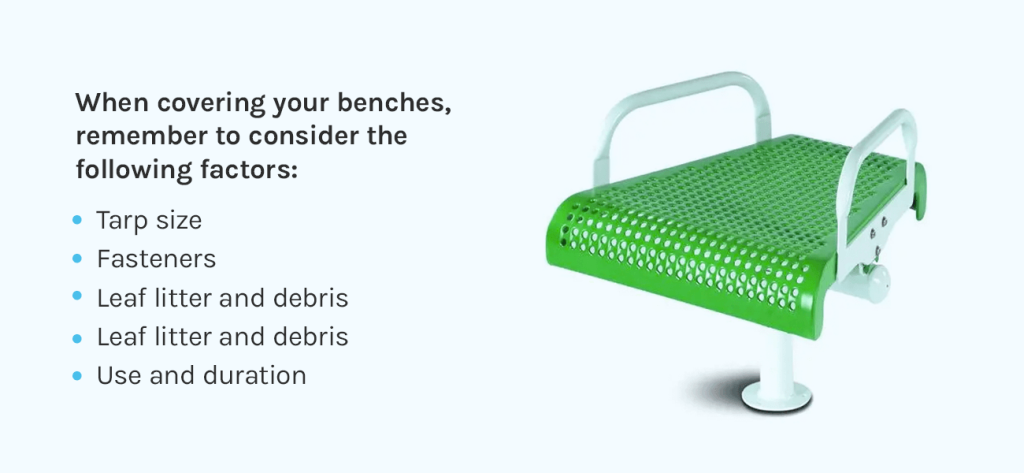
How Should You Clean a Bench?
Regularly cleaning your benches is an excellent way to preserve their quality while making them more inviting to visitors. When your benches look shiny and brand-new, they will look more appealing to people in the area. Your cleaning method might depend on the material. For example, you can clean most wood benches with gentle soap and water. Regardless of your material, you must dry it thoroughly afterward to prevent rust and rot from forming.
How Much Do Benches Cost?
How much is a wooden bench? Bench cost will depend on several factors, from manufacturer and material to design and protective measures. Establishing a budget during your planning process can help you determine what you can afford when you get to the purchasing stage.
What Is a Memorial Bench?
Memorial benches dedicate the seating solution to a specific person with a plaque on the back. These bench types are meaningful to many people, helping them remember a loved one’s life. Families often place them in locations significant to the person, enhancing their meaning. Knowing how to dedicate a bench to someone is a great way to honor a loved one and celebrate their memory.
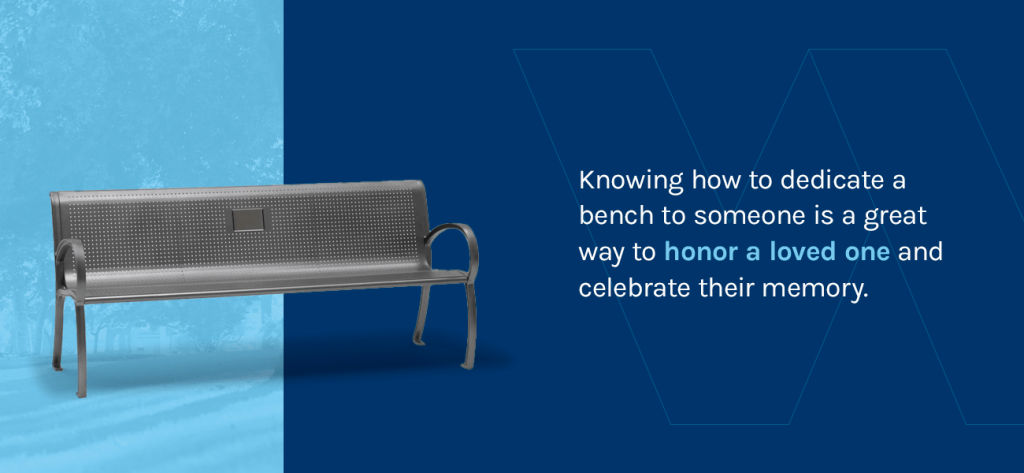
How to Make a Memorial Bench
When determining how to get a bench in memory of someone, you have multiple options. Some benches allow you to retrofit a plaque to the existing structure. This option is popular when families have a bench in mind. The location or structure might have had sentimental value to their loved one, making it more symbolic.
Wabash Valley Site Furnishings sells benches with plaques already fitted into their design, so you don’t have to figure out how to get a plaque on a bench. They come in several styles, so you can honor your visitors and their loved ones while supporting your style.
Can You Put a Memorial Bench Anywhere?
Families might have to get permission from several parties to get a memorial bench. If they want it on a specific property, they will need to work with the organization for approval. When determining how to get a memorial bench in a park or other public spaces, they might need to appeal to local governments or town councils. It’s hypothetically possible to put memorial benches almost anywhere, but there can be limitations depending on who controls the space.
Placing a memorial bench might come with stipulations from the organization. They might require families to maintain and repair the bench as necessary because they have limited resources. Other organizations might encourage people to create memorial benches with adopt-a-bench programs.
How Much Do Memorial Benches Cost?
Memorial bench cost will depend on the organization and manufacturer. Organizations might ask families to cover the purchase or installation costs for a memorial bench, while others will only request an adoption fee or plaque purchase. Developing your memorial policy and program can determine how much your customers will need to pay for a memorial bench on your property.
Invest in Outdoor Benches With Wabash Valley Site Furnishings
After deciding the details about your benches, you must determine where to buy an outdoor bench. Wabash Valley Site Furnishings offers a diverse selection of benches in ranging colors and styles, allowing you to discover the model that best suits your needs and aesthetic.
Explore our collection today and provide quality outdoor benches for your property’s visitors.

Categories
Recent Posts
Sign up for our newsletter
Share this post: